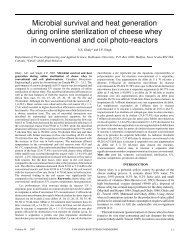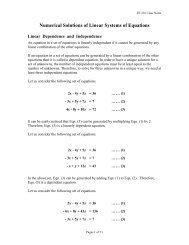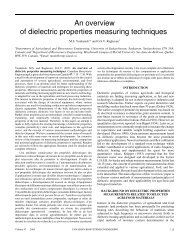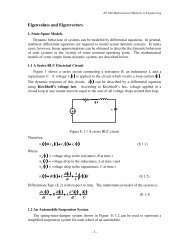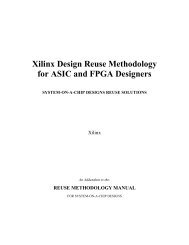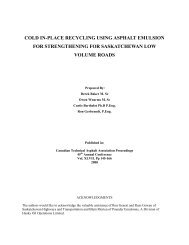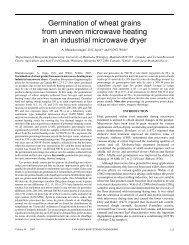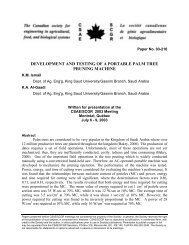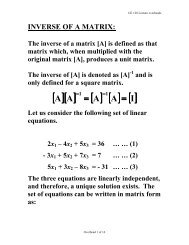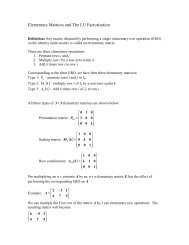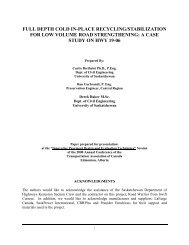Load factor calibration for the proposed 2005 edition of the National ...
Load factor calibration for the proposed 2005 edition of the National ...
Load factor calibration for the proposed 2005 edition of the National ...
Create successful ePaper yourself
Turn your PDF publications into a flip-book with our unique Google optimized e-Paper software.
430 Can. J. Civ. Eng. Vol. 30, 2003dards including <strong>the</strong> CEB (1976), AISC (1986), and ASCE(2000). Structural design based on this <strong>for</strong>mat uses loadcombinations <strong>of</strong> <strong>the</strong> <strong>for</strong>m[1] α + α S + α S∑p i i ij ji≠jwhere α P is <strong>the</strong> load <strong>factor</strong> applied to <strong>the</strong> effects due to permanentload, P, such as dead load; and α i is <strong>the</strong> load <strong>factor</strong>applied to <strong>the</strong> effects due to <strong>the</strong> principal transient load, S i ,assumed to be acting at its maximum value during <strong>the</strong> lifetime<strong>of</strong> <strong>the</strong> structure. The load <strong>factor</strong>s α ij applied to <strong>the</strong>companion-action transient loads S j represent <strong>the</strong>companion-action load effects that occur during <strong>the</strong> periodwhile <strong>the</strong> principal action is acting at its maximum value.An early objective <strong>of</strong> <strong>the</strong> <strong>calibration</strong> process was to determinewhe<strong>the</strong>r specified snow and wind loads should correspondto 50 year or 500 year return periods. The Task Groupon Snow and Wind <strong>Load</strong>s decided in October 2000 to recommendthat specified loads be based on 50 year returnperiods, in part because (i) <strong>the</strong>se values could be readily obtainedfrom existing databases; (ii) preliminary <strong>calibration</strong>indicated that load <strong>factor</strong>s less than 1.0 were required if500 year loads were specified; and (iii) 50 year return periodsare used <strong>for</strong> <strong>the</strong> loads specified in ASCE7-98 (ASCE2000).In this paper, <strong>the</strong> bases <strong>for</strong> <strong>the</strong> statistical parameters usedto characterize dead, live, snow, and wind loads are presented.These statistical parameters differ slightly from <strong>the</strong>values used to verify <strong>the</strong> 1977 NBCC reported by Nowakand Lind (1979). A companion paper summarizes results <strong>of</strong><strong>the</strong> <strong>calibration</strong>, describes <strong>the</strong> evolution <strong>of</strong> <strong>the</strong> recommendedload <strong>factor</strong>s in response to comments from <strong>the</strong> Task Groupon Snow and Wind <strong>Load</strong>s and o<strong>the</strong>rs, and summarizes <strong>the</strong> finalload <strong>factor</strong>s and load combinations recommended <strong>for</strong> <strong>the</strong><strong>2005</strong> NBCC.Dead loadDead load consists <strong>of</strong> <strong>the</strong> weights <strong>of</strong> a structural memberand <strong>the</strong> structural components that it supports, partitions,and permanent equipment. Although uncertain, it is commonlyassumed to remain constant during <strong>the</strong> service life <strong>of</strong>a structure. There is a tendency <strong>for</strong> <strong>the</strong> dead load to exceedits nominal value because <strong>the</strong> designer may overlook somethingin <strong>the</strong> dead load take<strong>of</strong>f, which is typically estimatedto within ±10% <strong>for</strong> buildings. Dead load uncertainty is because<strong>of</strong> dimensional tolerances and <strong>the</strong> uncertainty <strong>of</strong> unitweights <strong>of</strong> materials. Additional uncertainty is introducedthrough <strong>the</strong> process <strong>of</strong> converting <strong>the</strong> load into a load effect,which <strong>for</strong> indeterminate structures can be done accuratelyonly if <strong>the</strong> construction sequence is known. It is commonlyassumed that dead loads are normally distributed, perhapsbecause tolerances tend to be normally distributed, althoughno actual data seem to be available to verify this assumption.The dead load statistical parameters depend to some extenton <strong>the</strong> size <strong>of</strong> structure, <strong>the</strong> construction material used,and <strong>the</strong> quality control implemented. The weight <strong>of</strong> largestructural components is relatively insensitive to absolute dimensionaltolerances, so <strong>the</strong> dead load bias coefficients andcoefficients <strong>of</strong> variation are reduced. Improved qualitycontrolprocedures have <strong>the</strong> same effect. Geometric andmaterial unit weight variations are less <strong>for</strong> steel or precastconcrete components than <strong>for</strong> cast-in-place concrete construction.In particular, <strong>for</strong>mwork deflections in cast-in-placeconcrete floor construction can <strong>of</strong>ten cause <strong>the</strong> dead load tobe larger than <strong>the</strong> nominal value.A literature review indicated dead load itself has a bias, orratio <strong>of</strong> <strong>the</strong> mean to nominal values, from 1.00 to 1.05 and acoefficient <strong>of</strong> variation (CoV), <strong>the</strong> ratio <strong>of</strong> <strong>the</strong> standard deviationto <strong>the</strong> mean value, between 0.06 and 0.09. Modellingand analysis are typically assumed to be unbiased, withCoVs <strong>of</strong> 0.03–0.07, and increase <strong>the</strong> CoV <strong>of</strong> <strong>the</strong> dead loadeffect to between 0.05 and 0.10. Most investigators (StandardsAssociation <strong>of</strong> Australia 1985, South African Bureau<strong>of</strong> Standards 1989, and European Committee <strong>for</strong> Standardization1994, all reported by Kemp et al. 1998; Tabsh 1997;Ellingwood 1999) adopted a bias <strong>of</strong> 1.05 and a CoV <strong>of</strong> 0.10,as reported by Ellingwood et al. (1980), which were used <strong>for</strong><strong>the</strong> current investigation. For cases where <strong>the</strong> dead loadcounteracts <strong>the</strong> effects <strong>of</strong> o<strong>the</strong>r loads, <strong>the</strong> dead load wasassumed normally distributed with a bias <strong>of</strong> 1.00 and a CoV<strong>of</strong> 0.10.In response to comments from members <strong>of</strong> <strong>the</strong> TaskGroup on Snow and Wind <strong>Load</strong>s and <strong>the</strong> Canadian StandardsAssociation (CSA) Technical Committee on Rein<strong>for</strong>cedConcrete Design, <strong>the</strong> statistical basis <strong>for</strong> dead load<strong>factor</strong>s, including <strong>the</strong> accuracy <strong>of</strong> <strong>the</strong> analysis <strong>of</strong> dead loadeffects, was investigated. Findings are presented in this paperconcerning <strong>the</strong> original dead load statistics (Ellingwoodet al. 1980) and data from a new survey <strong>of</strong> concrete floorthickness variability. The companion paper summarizes related<strong>proposed</strong> revisions to NBCC Commentary G that reflect<strong>the</strong> accuracy <strong>of</strong> <strong>the</strong> analysis <strong>of</strong> dead load effects.“Original” dead load statistics and load <strong>factor</strong>sFor <strong>the</strong> past two decades, code calibrators around <strong>the</strong>world have characterized dead load effects as having a bias<strong>of</strong> 1.05 and a CoV <strong>of</strong> 0.10. The most detailed rationale <strong>for</strong><strong>the</strong>se numbers is presented in Appendix B <strong>of</strong> Ellingwood etal. (1980, p. 145) and is based on <strong>the</strong> statistics shown in Table1. The mean dead load is 1.0 × 4.8 + 1.1 × 1.9 =6.89 kPa, with a standard deviation <strong>of</strong> [(1.0 × 4.8 × 0.06) 2 +(1.10 × 1.9 × 0.15) 2 ] 1/2 = 0.43 kPa and CoV <strong>of</strong> 0.43/6.89 =0.062. The bias <strong>for</strong> <strong>the</strong> dead load effect, accounting <strong>for</strong> <strong>the</strong>load model and analysis parameters, is <strong>the</strong>re<strong>for</strong>e 6.89/6.70 ×1.0 × 1.0 = 1.03, with a CoV <strong>of</strong> (0.062 2 + 0.05 2 + 0.05 2 ) 1/2 =0.094. In <strong>the</strong>se computations, <strong>the</strong> bias and uncertainty <strong>of</strong> <strong>the</strong>superimposed dead load were relatively large, and <strong>the</strong> magnitude<strong>of</strong> <strong>the</strong> superimposed dead load is also large. Theimpact <strong>of</strong> <strong>the</strong> superimposed dead load was diminished, however,because it is a small fraction <strong>of</strong> <strong>the</strong> total dead load.In <strong>the</strong> derivation <strong>of</strong> <strong>the</strong> load <strong>factor</strong>s <strong>for</strong> <strong>the</strong> 1975 <strong>edition</strong> <strong>of</strong><strong>the</strong> NBCC, <strong>the</strong> dead load effect was assumed to have a bias<strong>of</strong> 1.00 and a CoV <strong>of</strong> 0.10, which included a CoV <strong>of</strong> 0.07<strong>for</strong> <strong>the</strong> trans<strong>for</strong>mation <strong>of</strong> dead load to dead load effect(Allen 1975). This <strong>calibration</strong> suggested a dead load <strong>factor</strong><strong>of</strong> 1.30, but this was reduced to 1.25 to maintain <strong>the</strong> sameratio <strong>of</strong> dead load <strong>factor</strong> to live load <strong>factor</strong> as was used at <strong>the</strong>time <strong>for</strong> ultimate strength design <strong>of</strong> concrete buildings.Survey in 2000 <strong>of</strong> concrete floor thickness variabilityMembers <strong>of</strong> <strong>the</strong> CSA Technical Committee on Rein<strong>for</strong>cedConcrete Buildings were invited to estimate typical floor© 2003 NRC Canada



